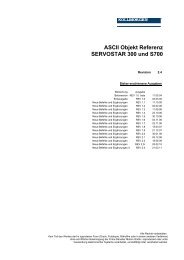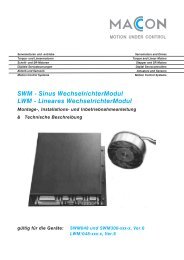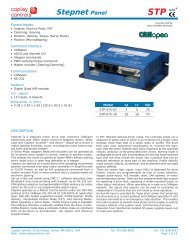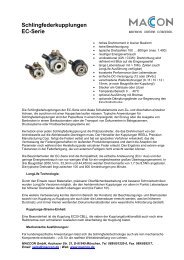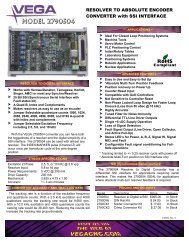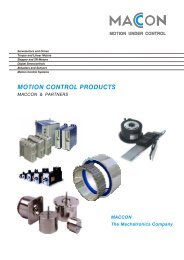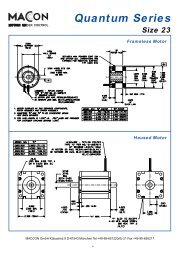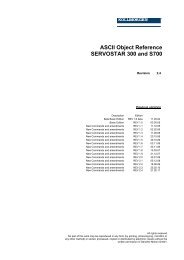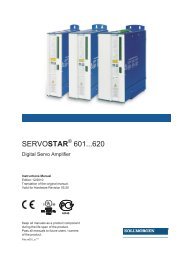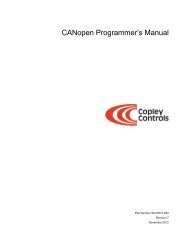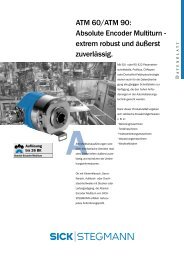Copley amplifier parameter dictionary - Maccon.de
Copley amplifier parameter dictionary - Maccon.de
Copley amplifier parameter dictionary - Maccon.de
Create successful ePaper yourself
Turn your PDF publications into a flip-book with our unique Google optimized e-Paper software.
<strong>Copley</strong> Amplifier Parameter Dictionary Amplifier Variables<br />
ASCII DvcNet Macro CAN ID:sub Bank Type Description<br />
10 If set, the homing sequence will run as normal, but the actual position will not be adjusted at<br />
the end. Note that even though the actual position is not adjusted, the <strong>parameter</strong> Homing<br />
Adjustment (p. 40) is updated with the size of the adjustment (in counts) that would have<br />
been ma<strong>de</strong>.<br />
Also, if bit 10 is set then no move to zero is ma<strong>de</strong> regardless of the setting of bit 9.<br />
0xC3 0xC4 0x4C3 0x6099:1 RF U32 Homing Velocity (fast moves). This velocity value is used during segments of the<br />
homing procedure that may be handled at high speed. Generally, this means move in<br />
which the home sensor is being located, but the edge of the sensor is not being<br />
found. Units: 0.1 counts/s.<br />
0xC4 0xC5 0x4C4 0x6099:2 RF U32 Homing Velocity (slow moves). This velocity value is used for homing segment that<br />
require low speed, such as cases where the edge of a homing sensor is being<br />
sought. Units: 0.1 counts/s.<br />
0xC5 0xC6 0x4C5 0x609A RF U32 Homing Acceleration/Deceleration. This value <strong>de</strong>fines the acceleration used for all<br />
homing moves. The same value is used at the beginning and ending of moves (i.e.<br />
there is no separate <strong>de</strong>celeration value). Units: 10 counts/s 2 .<br />
0xC6 0xC7 0x4C6 0X607C RF INT32 Home Offset. The home offset is the difference between the zero position for the<br />
application and the machine home position (found during homing). During homing<br />
the home position is found. Once the homing is completed the zero position is offset<br />
from the home position by adding the Home Offset to the home position. All<br />
subsequent absolute moves shall be taken relative to this new zero position. Units:<br />
counts.<br />
0xC7 0xC8 0x4C7 0X2350 RF U16 Homing Current Limit (home to hard stop mo<strong>de</strong> only). Home current in hard stop<br />
mo<strong>de</strong>, in which the <strong>amplifier</strong> drives the motor to the mechanical end of travel (hard<br />
stop). End of travel is recognized when the <strong>amplifier</strong> outputs the Hard Stop Mo<strong>de</strong><br />
Home Current for the Homing Current Delay Time (p. 41).Units: 0.01 A.<br />
0xC8 0xC9 0x4C8<br />
RF U16 Trajectory Profile Mo<strong>de</strong>. To set profile in CANopen see CAN object 0x6086 in the<br />
CANopen Programmers Manual. Bit-mapped as follows:<br />
Bits Description<br />
0-2 Give the trajectory profile mo<strong>de</strong>. The possible trajectory mo<strong>de</strong>s are <strong>de</strong>scribed below.<br />
Value Description<br />
0 Trapezoidal profile mo<strong>de</strong>. Uses position/distance, velocity, acceleration and<br />
<strong>de</strong>celeration. Any of those <strong>parameter</strong>s may be changed during the move. Jerk is not<br />
used in this mo<strong>de</strong>.<br />
<strong>Copley</strong> Controls Page 44





